Our tour of Sutera (Caltanissetta) is best started in Piazza Sant’Agata, where we will see the fifteenth-century Church of St. Agata. This contrasts with the nineteenth-century Town Hall. There are three naves inside the church, with a Barrel Vault at the center and large arches. The fifteenth-century marble statue Delle Grazie as well as the Mariano Rossi painting of the Madonna degli Innocenti (both from the mid-eighteenth century).
We walk through Via Roma and pass the remains of the 15th-century Salamone Palace. The Church of Maria Santissima del Carmelo was built in 1185 and rebuilt in 1934. It has a porch that allows you to see inserts from the Rabato Mosque on the gateway. The Museum of Rural Life is located in the small convent to the right. You will find the Madonna del Soccorso, which is a marble masterpiece featuring three naves by Bartolomeo Bernettaro. It was constructed in 1503 after it was commissioned by Salamone, whose sarcophagi are located next to the chapel.
Walking along Via Carmine, we reach the Rabato neighborhood. This is a place at the edge of the village that was founded by the Arabs in 860 AD. The Rabad consisted of a collection of plaster houses that were attached to one another, with narrow streets, steep staircases, and beams. It is possible to still see the Arab village, especially from the top of a mountain. There are old Sicilian tiled roofs and narrow streets that remind one of the Arabic casbahs. The dammuso is a Sicilian plaster farmhouse that has only one lofted space and was built on one level. The Arab settlement lies under many layers of construction. In 1370, Baron Giovanni Chiaramonte built the Mother Church Santa Maria Assunta upon the mosque that was built around 875. The church was then restored in 1585 with a Renaissance portal and a 1495 marble baptismal font. Nevertheless, there are some Architectural Items that remain from the mosque, which can be seen on the wall above or from the four plaster niches.
Let’s take some deep breaths! We will start at Piazza del Carmine and climb the 183 steps up to Monte San Paolino (812m high). Giovanni Chiaramonte, a 1370s architect, built the sanctuary San Paolino on top of the castle’s walls. The church is located next to a small eighteenth-century convent of Philippine Fathers. There, we find a Filippo Tancredi painting, the Madonna Trono fra I Santi Damiano e Cosma and two amazing urns (relics), which are expressions of an ancient Sicilian Goldsmith. The bones of San Paolino can be found in one of the two, which dates back to 1498. The other, made by Francesco Rivelo from Sicilian, contains the bones and relics of St. Onofrio.
The split hill or jacca-fenditura is a hill made up of two pieces separated by a gap. Legend has it that Jesus’ last breath split the rock. Let’s now follow a path to the top of San Marco hill and discover the figureddi, Byzantine-style frescos depicting the four Evangelists. They were probably created by Byzantine monks who arrived between the IV and VI centuries.
It’s fascinating to watch how craftsmen work. They skillfully weave lu panru, which is a basket of olive branches and sometimes willow and/or elm.
What food should we eat? Real food made with olive oils and local cheeses. Let’s try the maccu di fave (broad bean cream) or the viciddata, which is a dessert with nuts, figs, and almonds if it’s the right moment.
